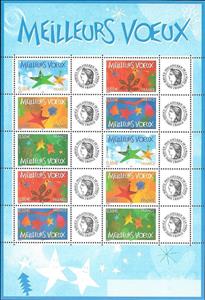Souvenir Sheet: Best Wishes 2004 (France 2004)
Best Wishes 2004 (France 2004)
12 November (France ) within release Celebration goes into circulation Souvenir Sheet Best Wishes 2004 face value 10*0.50 Euro
| Souvenir Sheet Best Wishes 2004 in catalogues | |
|---|---|
| Yvert et Tellier: | Yt: FR F3722A |
| Michel: | Mi: FR 3872Zf-3876ZfKB |
Souvenir Sheet is vertical format.
Souvenir sheet of 10 stamps (2 pairs of 5 stamps) each with a worthless thumbnail "Philatelic Service of the Post" or "Personalized stamps" - Note that the thumbnail can be customized in a personal way - The gum can be matte or shiny -Also in the issue Celebration:
- Se-tenant - Best Wishes 2004 - Stars and crescent moon face value 0.50;
- Se-tenant - Best Wishes 2004 - Star and flower face value 0.50;
- Se-tenant - Best Wishes 2004 - Stars with a snowball face value 0.50;
- Se-tenant - Best Wishes 2004 - Stars and crescent moon face value 0.50;
- Se-tenant - Best Wishes 2004 - Stars, bird, plant face value 0.50;
- Souvenir Sheet - Best Wishes 2004 face value 10*0.50;
- Se-tenant - Best Wishes 2004 - Star and flower face value 0.50;
- Se-tenant - Best Wishes 2004 - Stars and christmas decorations face value 0.50;
- Se-tenant - Best Wishes 2004 - Star, bird, plant face value 0.50;
- Se-tenant - Best Wishes 2004 - Star and christmas decorations face value 0.50;
- Stamp - Best Wishes 2004 - Stars with a snowball face value 0.50;
Souvenir Sheet Best Wishes 2004 it reflects the thematic directions:
Christmas or Christmas Day (Old English: Crīstesmæsse, meaning "Christ's Mass") is an annual festival commemorating the birth of Jesus Christ, observed most commonly on December 25 as a religious and cultural celebration among billions of people around the world. A feast central to the Christian liturgical year, it is prepared for by the season of Advent or the Nativity Fast and initiates the season of Christmastide, which historically in the West lasts twelve days and culminates on Twelfth Night; in some traditions, Christmastide includes an Octave. The traditional Christmas narrative, the Nativity of Jesus, delineated in the New Testament says that Jesus was born in Bethlehem, in accordance with messianic prophecies; when Joseph and Mary arrived in the city, the inn had no room and so they were offered a stable where the Christ Child was soon born, with angels proclaiming this news to shepherds who then disseminated the message furthermore. Christmas Day is a public holiday in many of the world's nations, is celebrated religiously by the vast majority of Christians, as well as culturally by a number of non-Christian people, and is an integral part of the holiday season, while some Christian groups reject the celebration. In several countries, celebrating Christmas Eve on December 24 has the main focus rather than December 25, with gift-giving and sharing a traditional meal with the family.
A star is a luminous spheroid of plasma held together by self-gravity. The nearest star to Earth is the Sun. Many other stars are visible to the naked eye at night; their immense distances from Earth make them appear as fixed points of light. The most prominent stars have been categorised into constellations and asterisms, and many of the brightest stars have proper names. Astronomers have assembled star catalogues that identify the known stars and provide standardized stellar designations. The observable universe contains an estimated 1022 to 1024 stars. Only about 4,000 of these stars are visible to the naked eye—all within the Milky Way galaxy.


